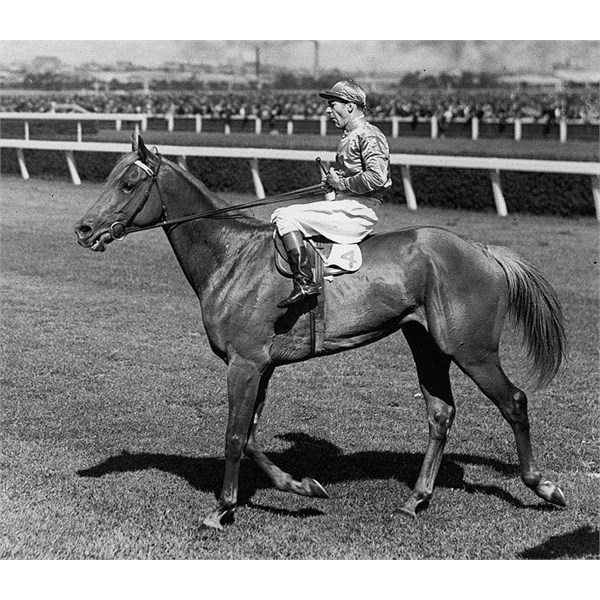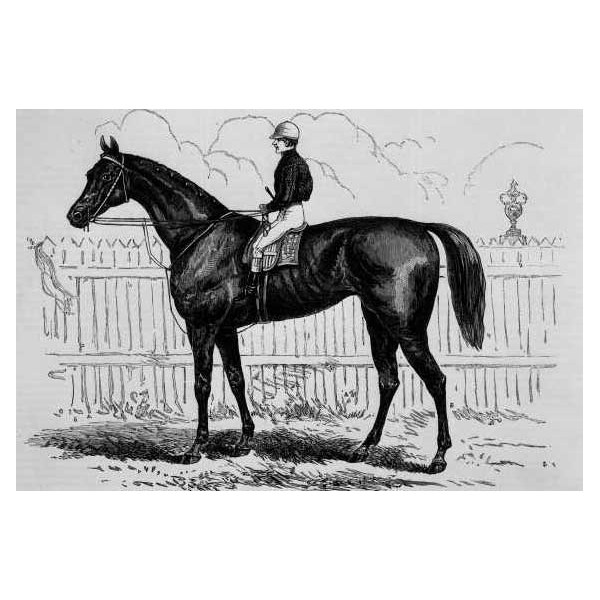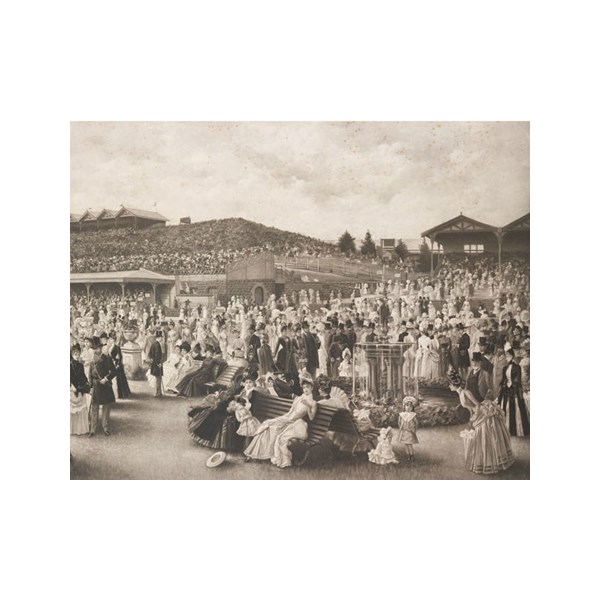The
Melbourne Cup is Australia's major thoroughbred horse race. Marketed as "the race that stops a nation", it is a 3,200 metre race for three-year-olds and over. It is the richest "two-mile" handicap in the world, and one of the richest turf races. Conducted by the Victoria Racing Club on the Flemington Racecourse in
Melbourne, Victoria, the event starts at 3pm (daylight saving time) on the first Tuesday in November.
The winner of the first
Melbourne Cup in 1861 received a gold watch. The first
Melbourne Cup trophy was awarded in 1865 and was an elaborate silver bowl on a stand that had been manufactured in England.
The silver trophy presented in 1867 was also made in England but jewellers in Victoria complained to the Victorian Racing Club that the trophy should have been made locally. They believed the work of Melburnian William Edwards to be superior in both design and workmanship to the English made trophy. No trophy was awarded to the
Melbourne Cup winner for the next eight years.
Seventeen horses contested the first
Melbourne Cup on Thursday 7 November 1861, racing for the modest prize of 710 gold sovereigns (£710) cash and a hand-beaten gold watch, winner takes all.The prize was not, as some have suggested, the largest purse up to that time.

Artists drawing of Archer

The Backers' Guide for the Year 1874
In order to attract a bigger crowd to the fledgling Cup, the first secretary of the Victorian Racing Club, Robert Bagot decided to issue members with two ladies tickets, calculating that "where ladies went, men would follow". A large crowd of 4,000 men and women watched the race, although it has been suggested this was less than expected because of news reaching
Melbourne of the death of
explorers Burke and Wills five days earlier on 2 November. Nevertheless the attendance was the largest at Flemington on any day for the past two years, with the exception of the recently run Two Thousand Guinea Stakes.
The winner of this first
Melbourne Cup race was a 16.3 hand bay stallion by the name of Archer in a time of 3.52.00, ridden by John Cutts, trained by Etienne de Mestre, and leased (and consequently raced in his own name) by de Mestre. As a lessee de Mestre "owned" and was fully responsible for Archer during the lease. Archer was leased from the "Exeter Farm" of Jembaicumbene near
Braidwood, New South Wales. His owners were Thomas John "Tom" Roberts (a good school-friend of de Mestre's), Rowland H. Hassall (Roberts' brother-in-law), and Edmund Molyneux Royds and William Edward Royds (Roberts' nephews).
The inaugural
Melbourne Cup of 1861 was an eventful affair when one horse bolted before the start, and three of the seventeen starters fell during the race, two of which died. Archer, a
Sydney "outsider" who drew scant favor in the betting, spread-eagled the field and defeated the favourite, and Victorian champion, Mormon by six lengths. Dismissed by the bookies, Archer took a lot of money away from
Melbourne, 'refuelling interstate rivalry' and adding to the excitement of the Cup. The next day, Archer was raced in and won another 2 mile long distance race, the
Melbourne Town Plate.
It has become legend that Archer walked over 800 km (over 500
miles) to Flemington from de Mestre's stable at "Terara" near Nowra, New South Wales. However, newspaper archives of the day reveal that he had travelled south from
Sydney to
Melbourne on the steamboat City Of
Melbourne, together with de Mestre, and two of de Mestre's other horses Exeter and Inheritor. Before being winched aboard the steamboat for the trip to
Melbourne, the horses had arrived in
Sydney in September 1861.
Archer travelled to
Melbourne by steamboat again the following year 1862 to run in the second
Melbourne Cup. This time he won 810 gold sovereigns (£810) cash and a gold watch before a crowd of 7,000, nearly twice the size of the previous years large crowd in a time of 3.47.00, taking to two the number of
Melbourne Cup wins by this horse. Archer had already won the 1862 AJC Queen Elizabeth Stakes in Randwick,
Sydney, and returned to win his second
Melbourne Cup carrying 10 stone 2 pounds. He defeated a field of twenty starters by eight lengths, a record that has never been beaten, and that was not matched for over 100 years. Mormon again running second. Winning the
Melbourne Cup twice was a feat not repeated until more than seventy years later when Peter Pan won the race in 1932 and 1934, and winning the
Melbourne Cup two years in a row was a feat not repeated until more than 30 years later when Rain Lover won in 1968 and 1969.

1932 & 1934 winner Peter Pan ridden by jockey Darby Munro

1934 VRC Melbourne Cup racebook

The 1934 Melbourne Cup, an 18ct gold, won by Peter Pan

The inscription on the cup reads 'Melbourne Cup, 1934. Won by Mr RR Dangar's Peter Pan, age 5 yrs. Weight 8st 10lb'.
In 1865, Adam Lindsay
Gordon wrote a verse in which the
Melbourne Cup winner was called Tim Whiffler. Two years later in 1867 two horses with the name Tim Whiffler ran in the
Melbourne Cup. (The year before in 1866 two horses with the same name, Falcon, also ran in the
Melbourne Cup.) To distinguish between the two Tim Whifflers they were called "Sydney" Tim Whiffler and "Melbourne" Tim Whiffler. "Sydney" Tim Whiffler actually won the Cup. He was trained by Etienne de Mestre, and like Archer before him raced in de Mestre's name but was leased from the "Exeter Farm".
As early as 1865, Cup day was a half-holiday in
Melbourne for public servants and bank officials. Various businesses also closed at lunchtime.
It took some years before the purpose of the declared holiday was acknowledged in the Victoria Government Gazette. The Gazette of 31 October 1873 announced that the following Thursday (Cup Day) be observed as a bank and civil (public) service holiday.
On 7 November 1876, the running of the
Melbourne Cup on the first Tuesday in November saw the three-year-old filly, Briseis, owned and trained by James
Wilson Snr., win in a time of 3.36.25. Briseis then went on to creat a record that is never likely to be equalled, winning the VRC
Derby, the
Melbourne Cup and the VRC Oaks in the space of six days. She was ridden in the
Melbourne Cup by the tiny featherweight figure of jockey Peter St. Albans. In 1876 at the recorded age thirteen (he was actually twelve, being 8 days short of his thirteenth birthday).Peter St. Albans is also the youngest person ever to win a
Melbourne Cup. Before 75,000 at Flemington Briseis, with
St Albans in the saddle, comfortably won by 1 length in the biggest field of all time. "At 4 o'clock the starter released the 33 runners and they swept down the long Flemington straight in a thundering rush. Briseis, ridden by what one writer termed a mere child, (in the Cup) captured a rare double, the Victoria Race Club
Derby and the
Melbourne Cup. Shouts and hurrahs were heard, hats were thrown in the air and one excited individual fell on his back in the attempt to do a somersault. The boy who rode the winner was carried around the pack and is the hero of the day," reported the "Australasian Sketcher" in 1876. Both Peter St. Albans and Briseis have now become racing legends, and Briseis is regarded as one of the greatest mares foaled in Australia.

Briseis and Peter St Albans

The Lawn at Flemington on Melbourne Cup Day 1889
Briseis wasn't the only sensation surrounding the 1876
Melbourne Cup. Two months before the event, on Saturday 9 September, the City Of
Melbourne sailed for
Melbourne from
Sydney with a cargo including 13 racehorses, many of whom were considered serious contenders for the
Melbourne Cup. The following day the ship ran into a savage storm and was hit by several rogue waves, with Nemesis (the winner of the 1876 AJC Metropolitan Handicap in Randwick,
Sydney and favourite for the Cup, owned by John Moffat) and Robin Hood (another favourite, owned by Etienne de Mestre) being among the 11 horses that were killed. Betting on the big race was paralysed. To the dismay and anger of the public, bookmakers, showing no feeling, presented a purse (loaded with coins) to the captain as token of their appreciation for his part in saving them many thousands of pounds in bets already laid on the favourites who had perished. Perhaps they should have kept their money, however. The outsider Briseis comfortably won by 1 length in the biggest field of all time, and in an extremely good time, so it is unlikely that the horses who perished could have beaten her.

Phar Lap winning the Melbourne Cup Race from Second Wind and Shadow King on 5 November 1930

The winner of the 1952 Melbourne Cup - New Zealand champion Dalray ridden by W Williamson
1877 is also the year that the trainer Etienne de Mestre won his fourth
Melbourne Cup with Chester owned by Hon. James White. In 1878, as in previous years De Mestre fielded more than one horse. He entered the favourite Firebell (owned by W.S. Cox) who finished last, Chester (owned by Hon. James White) the previous year's winner who fell, and Calamia (owned by de Mestre) who, though less fancied, won easily by two lengths. First prize was £1,790, the crowd was 80,000 and there were 30 starters. De Mestre's 1878 win with Calamia brought to 5 the number of
Melbourne Cups he had won. This record was not to be matched for nearly 100 years when the trainer Bart Cummings won his fifth
Melbourne Cup in 1975. Bart Cummings, regarded as the best Australian horse trainer of all time, went on to win 12
Melbourne Cups to 2008, and is still training horses.
Good luck to all the Punters come Tuesday.
.